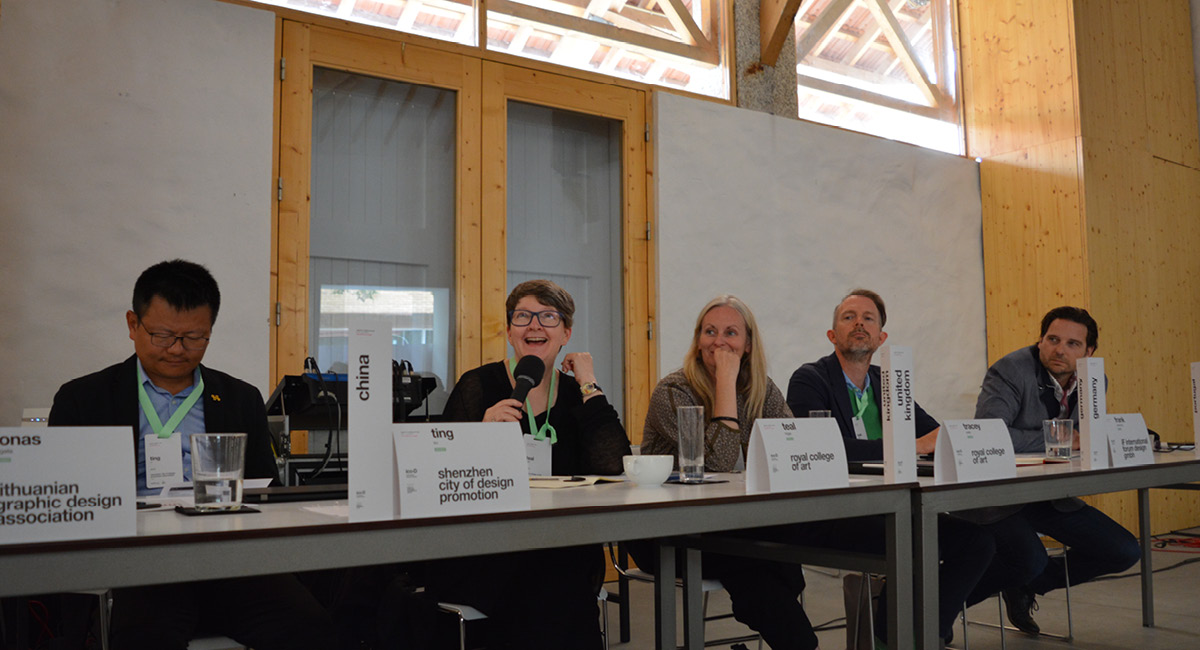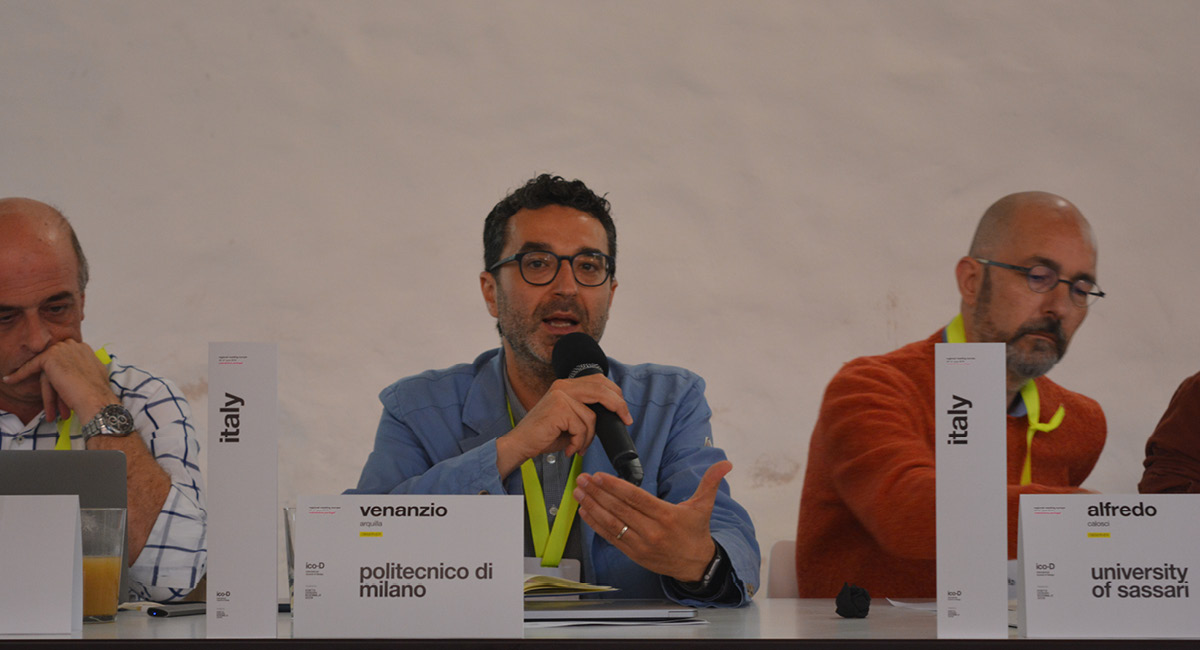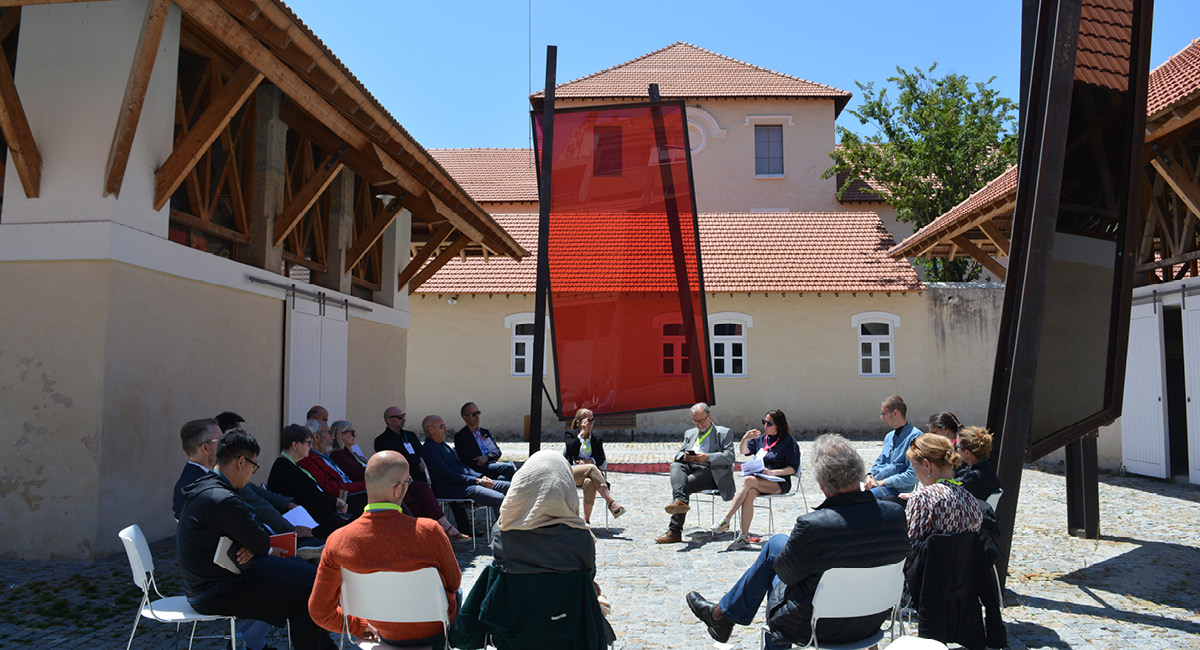RM2019 matosinhos
From 20.06.2019 to 21.06.2019 Regional Meeting Europe
PortugalThe ICoD Regional Meeting Europe (RM EURO 2019) took place on 20-21 June 2019 in Matosinhos (Porto) and was hosted by the Porto Design Biennale organisation.
The ICoD Regional Meetings (RMs) are a key part of the Council’s international programming. RMs provide an opportunity for ICoD Members to engage with the design community at the regional level on common topics and challenges – in an international context. Europe has long enjoyed the status of leader in the design industry. With many of the world’s oldest national professional designer organisations, many well-known design schools and the head offices of many international design companies, the rest of the world has often looked to Europe for setting standards, new technologies and for a large part of the recorded history of design. But the world is changing.
 Above: Desmond Laubscher, Özüm Ak, Emanuel Barbosa, Tracey Waller, Federico Del Rosso
Above: Desmond Laubscher, Özüm Ak, Emanuel Barbosa, Tracey Waller, Federico Del Rosso
Production has moved largely East and South, but not only production. The market for design consumption is becoming worldwide with increasing demand in South-East Asia, China, the Middle East and China. This market will grow explosively in the coming decades, directly impacting designers everywhere.
Work itself has changed for designers. Practice is now increasingly global. With global sourcing, the capacity to co-create across time zones, and the mobility of the workforce and the consumer, the industry is evolving at a dizzying pace.
 Above: Ting Xu, Teal Triggs, Tracey Waller, Frank Zierenberg and Jeremy Hugh Aston
Above: Ting Xu, Teal Triggs, Tracey Waller, Frank Zierenberg and Jeremy Hugh Aston
TOPICS
With regional and global considerations in mind, ICoD covered five topics specific to the European context. Download the programme here.
Topic 1: public design policy
While the European Union is currently the second largest economy in the world in nominal terms (after the United States) and according to purchasing power parity (after China), we all feel the ground starting to shift under us. The pace of Globalisation and its adherent technologies is not slowing down. People are moving and connecting in larger numbers and faster. Our competitors are no longer our neighbours. We now compete with, and outsource beyond, our own geographical location for high quality design services from places like Buenos Aires, Chengdu and Bali. With this increased competition so comes opportunity, because nothing is stopping clients abroad — China is now the world’s biggest consumer — from buying the established design brands of France, Sweden or Italy.
Smart governments at all levels — national, regional and municipal — are building policies to support everything from design education, to business aid for design SMEs, to reinforcing local design industry through procurement initiatives and putting in place tax cuts to bolster local design-based manufacturing industries. These measures give designers a leg-up on competition, giving value in ways that are both local and far-reaching. Public design policies sharpen local competencies, give opportunities to grow (effectively incubating businesses) and contribute to educating society at large to be better, more responsible consumers.
 Above: Venanzio Arquilla and Alfredo Calosci
Above: Venanzio Arquilla and Alfredo Calosci
Topic 2: metrics + data
The nuts and bolts of gathering complex information and knowledge (data) and devising systems to measure it (metrics) is a resource-consuming exercise. Currently, most national-level census data on design industries and professions is incomplete. And without metrics, only a very partial picture of the design ecosystem is revealed. If governments had straightforward data on design it could empower them to put design policy in place and help them govern in ways that better capitalise on what the design industry has to offer. In this way, this topic is correlated to last week’s topic “Public Design Policy”.
Having clear data to describe and position the design workforce — the numbers of working designers and their contributions to the economy— is key for design organisations requesting government funds to develop resources for this sector, but also for these organisations to better understand their roles vis a vis the designers they serve.
After a decade or so of the corporate world co-opting terms like “design-thinking” and “innovation” to capitalise on the “power” of design for business, business — in the form of the big management consulting companies — is starting to understand that actual design, performed by professional designers, has an important role to play in business development. Deloitte now has its own “Design & Innovation” consultancy (Fjord). McKinsey is producing industry reports on both design and fashion, and the Boston Consulting Group has acquired a digital design and innovation lab to focus on the intersection of “human experience and technology”. Designers do not need big management consulting companies to understand their potential (or maybe they do?) but these case studies are a strong business argument for designers throughout Europe to better package and explain their value.
 Above: Özüm Ak, Maria Da Gandra and Benedicte Wildhagen
Above: Özüm Ak, Maria Da Gandra and Benedicte Wildhagen
Topic 3: globalisation
Globalisation is causing enormous economic, political and social disruption. The promises of faster and easier travel, better telecommunications and technologies that translate, connect, share and bring each of us closer — at least digitally— are moving entire industries across borders, opening up new markets, boosting certain sectors and opening an even wider divide between the haves and have nots. Whether consciously or not, designers play a primary role in this change and are also greatly affected by it as a profession. The attributes of tomorrow's markets, products and services are being determined today by social developments in distant lands and it is incumbent on designers, and particularly design organisations and entities, to better understand the implications of this.
Countries like China and India are becoming not only sophisticated manufacturers but important world markets for goods. Where once it might have been enough to develop relations with key factories or develop partnerships to set up manufacturing plants to sell competitively to the rest of the planet, today any brand not selling to these markets is missing out on key growth sectors. But if we meet this growing market demand and produce as much for China and India as we do for North America and Europe, aren't we are going to be drowning in 'stuff'? Designers play a pivotal role in this evolution, mainly to assert their position as defenders of the interests of the end-user and to divert a situation which will have disastrous impacts on the planet. This includes making actual sustainable decisions — including making less— and finding solutions that take into consideration issues like accessibility, equality and improvement of quality of life. Are we equipping designers with the tools to cope with the full implications of globalisation?
 Above: David Grossman, Ting Xu, Federico Del Rosso, Zinia Nizar, Gabriel Patrocinio and James Chu
Above: David Grossman, Ting Xu, Federico Del Rosso, Zinia Nizar, Gabriel Patrocinio and James Chu
Topic 4: Design Agenda
Mohandas Gandhi published, in 1913, a book about snakebites that included the now well-known aphorism "If we could change ourselves, the tendencies in the world would also change. As a man changes his own nature, so does the attitude of the world change towards him." Though it is clear we have much work to do in convincing external stakeholders to take design seriously, a key element of this will be to convince designers themselves to challenge the way they see their role. Designers can either see themselves as helpless in front of the demands of their clients, in front of legislation in their countries, in front of knowledge and resource challenges or they can choose to re-evaluate their role and see themselves as advocates for the end-users of their products, as ambassadors of their environment and as potent actors changing an outdated working model that is not benefiting society.
Revolutionary? Maybe. But designers fundamentally want to make the world better. And they have the tools to make a difference. So maybe it is our role — as the institutions and organisations that represent them — to advocate for their empowerment. Let's re-write the Design Agenda together.
Topic 5: Collaboration
The International Council of Design is a fairly small organisation. So are each of our 120 Member organisations. Some are larger than others, some are better funded than others, some have many more years of history than others, or many more members but if we are really honest with ourselves, none of us — alone —have the influence to impact the types of changes we want to make. But what if each of us held the key to a part of the solution?
As design professionals, we know that a very important first step in the design process is an assessment of both the problem and the resources available. Not the problem as it is described by the client, necessarily. And not always the most obvious available resources. Good designers will dig deeper at this stage in the design process to ask more probing questions: is that the real problem or a symptom of a greater issue? (Do you really need a disposable plate or can the problem actually be better solved by designing a better system to clean re-usable plates)? Do we only have the quoted budget to work with or are there additional resources available (expertise, existing infrastructure, budgets from other departments that will profit from our solution)?
We are proposing that the consolidation of the design industry should be approached in a similar fashion. Why should we compete to offer the same services or develop the same tools, when we could all be working on complimentary projects and pooling them amongst ourselves?

PARTICIPANTS
Members
Özüm Ak Turkish Society of Graphic Designers (GMK) TURKEY
Yunus Ak Turkish Society of Graphic Designers (GMK) TURKEY
Maria Da Gandra London College of Communication (LCC) UNITED KINGDOM
Federico Del Rosso Associazione per il Disegno Industriale (ADI) ITALY
Jonas Liugaila Lithuanian Graphic Design Association LITHUANIA
Teal Triggs Royal College of Art UNITED KINGDOM
Tracey Waller Royal College of Art UNITED KINGDOM
Ting Xu Shenzhen City of Design Promotion Association CHINA
Frank Zierenberg iF International Forum Design GmbH GERMANY
Host
Eduardo Aires Porto Design Biennale PORTUGAL
Andrew Howard ESAD PORTUGAL
Jeremy Hugh Aston ESAD PORTUGAL
Observer
Venanzio Arquilla Politecnico di Milano ITALY
Emanuel Barbosa esad—idea PORTUGAL
José Bartolo ESAD PORTUGAL
Alfredo Calosci University of Sassari/Alghero ITALY
James Chu Macau Designers Association CHINA
Christina Melander Danish Design Centre DENMARK
Gabriel Patrocinio Instituto Superior Manuel Teixeira Gomes (ISMAT) PORTUGAL
Pedro Trindade Associação das Indústrias de Madeira e Mobiliário de Portugal—AIMMP PORTUGAL
Benedicte Wildhagen Design and Architecture Norway (DOGA) NORWAY
CONTACT
Send any ICoD Event related inquiries to Event Manager Elizabeth Carbonell events@theicod.org